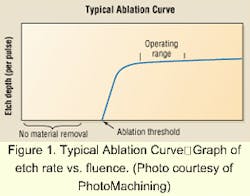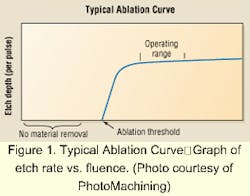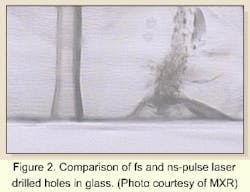A closer look at laser ablation
Ronald D. Schaeffer
FACTORS THAT INFLUENCE ABLATION MECHANISMS INCLUDE LASER WAVELENGTH, ENERGY ON TARGET, PULSE LENGTH AND REPETITION RATE, AS WELL AS THE NATURE OF THE TARGET MATERIAL ITSELFI am frequently asked to define the word 'ablation'. The dictionary definition is either a wearing away by heat (examples are glaciers and rocket nose cones) or the surgical removal of a body part. Let's concentrate on the former. The word was first used, relating to lasers, to describe material removal with infrared lasers.
Pretty clearly this fits the definition reasonably well as the primary interaction of red photons with most materials is thermal in nature via dumping energy into molecular vibrational energy levels. However, it has also been asserted that ablation refers to the removal of material using UV photons where the photon energy is high enough to break atomic bonds, resulting in 'cool' laser processing. Does this fit the definition?
Recently it has been found, when using very short laser pulses in the picosecond or femtosecond range, that clean material removal is relatively independent of wavelength. Since these pulses occur on a time scale approximating the molecular motions, it can be asserted that the process is non-thermal, as is born out in practice by the excellent quality of features processed with short pulse lasers. Is this therefore ablation?
Further considerations
Figure 1 shows a typical ablation curve for pulsed (or q-switched) lasers. At low target energy density (fluence), there is no material removal. As the energy density is increased, a point is reached, called the 'ablation threshold', where material removal begins. As the fluence increases, there is more material removed per volume of photons until the point where the curve plateaus. Once the curve has reached this plateau the amount of removed material is not further increased with increasing fluence, so it is generally not beneficial to run at laser fluences much beyond this point, as thermal side effects will become more pronounced. The energy of the additional photons, since it is not being used to eject material, therefore transforms to heat and can cause secondary thermal effects.
It is interesting to note that the shape of this curve is pretty independent of wavelength of laser light.
The most imp- ortant criteria is that the material has absorption at the laser wavelength chosen with strongly absorbing materials preferred.
We have to remember that the important consideration is peak power, which is dependent on the temporal beam profile and therefore the laser pulse length. In general, a shorter pulse length will produce less thermal effects. By the nature of the way the UV photons are made in commercially available lasers (excimer and frequency shifted solid state lasers), the pulse lengths are usually on the order of nanoseconds, giving peak powers in the kW range. CO2 lasers on the other hand usually have pulse lengths in the millisecond range and, even though the total output energies are very large, the resulting peak powers are small. Short pulse lasers on the other hand can have very high peak powers even though the total output energy is low due to the short pulse length. Basically the peak power (in Watts = Joules/second) is equal to the energy (Joules) divided by the pulse length (seconds).
Therefore, either an increase in energy or a decrease in pulse length will increase the peak power. Figure 2 shows holes in glass drilled with both a fs and ns-pulse length laser. Thermal effects can clearly be seen in the ns hole on the right, whereas the fs hole on the left is very cleanly drilled. Note that these discussions have been limited to exclude cw lasers as they generally do not have sufficient peak powers to affect material removal and are generally not used in laser machining except in some special cases.
Other factors to consider are the secondary effects. For instance, even though UV light may interact with materials by bond breaking on a first order basis, there can be significant thermal activity if the UV photons cannot be efficiently absorbed. There are a number of reasons why this may occur. First, the penetration depth of materials in the UV is very small, resulting in a small interaction volume. This is why there is potentially more control when machining with UV lasers, but speed is sacrificed for that control. Because of this small interaction volume, frequently the leading edge of a laser pulse is absorbed efficiently by the target material, while photons in the tail of the pulse interact only with the plasma formed by the leading edge photons. This problem is further compounded when the repetition rate of the laser gets high enough so that next pulse sees the expanding plasma plume from the first pulse, further decreasing laser efficiency and therefore increasing the potential for thermal side effects.
Thermal effects also become more pronounced as the aspect ratio (feature depth to feature diameter) increases. There are several factors involved, and they can be illustrated by considering the percussion drilling of a hole. The first is diffraction of the light caused by the entrance hole. The second involves internal reflections from the side walls as the hole goes deeper, resulting in 'waveguiding'. The third is the increasing inability of the plasma to escape from the hole before the arrival of the next laser pulse. All of these factors contribute to the end resultnamely the taper associated with the laser drilling and the increasing thermal effects as the aspect ratio increases.
It should also be noted that, when drilling a through hole, the material may not be uniformly removed on the exit hole side. The beam tends to be 'hotter' on the edges and therefore the edges drill a bit faster so that, if one looks at a 'blind' hole, one frequently sees the edges etched deeper and a 'bump' in the middle. For 'soft' materials, like plastic films, this means that there are sometimes 'flaps' that can be formed that may not drill through if there is no backer material. For hard materials, like ceramics, there may be 'chip out' on the exit side. This is a result of the fragile material fracturing close to the break through point because of the acoustic shock of the plasma exiting the hole. An analogy is drilling a piece of wood with a mechanical drill press. If there is no backer material, there is splintering at the exit. Although this process is caused by laser light, I would not consider this form of material removal to be strictly ablation as it is more of a mechanical removal mechanism. There is also another process that effectively removes material but may not be considered as ablationlaser melting and reflow. A classic example is CO2 laser wire stripping of polyurethane where the molten dielectric 'beads' on the wire, forming droplets or ridges that thus expose the underlying conductor.
Conclusion
In conclusion, the simple act of material removal by laser light can be considered 'laser ablation' regardless of the mechanism, wavelength, pulse length or any other factor. Factors that influence ablation mechanisms include laser wavelength, energy on target, pulse length and repetition rate, as well as the nature of the target material itself. Although these factors influence just how the material is removed, in principle the result can be defined as laser ablation.
ACKNOWLEDGMENT:
I would like to thank William Clark of Clark MXR for providing Figure 2.
Ronald D. Schaeffer is CEO, PhotoMachining, Inc. (Pelham, NH). He can be contacted at (T) 603-882-9944, (F) 603-886-8844, or e-mail: [email protected]


